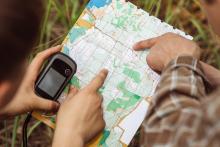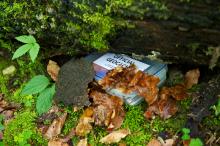What is geocaching?

This fun pastime is a mix between treasure hunting and hide-and-seek that challenges participants of all ages to find caches using GPS coordinates. It started in 2000 with one person placing a single spot in Oregon and has now grown to more than 3 million geocaches throughout 190 countries. In Macomb County alone, there are more than 10,000 of all types.
Common geocache types include:
- Traditional: This type of geocache is the most basic and just simply has a container at the given coordinates.
- Multi-cache: These geocaches involve two or more locations, with clues at each until the final destination, which has the physical container with a logbook inside.
- Puzzle cache: This type often involves complicated puzzles that must first be solved in order to determine the correct coordinates of the cache or to open a cache container.
- EarthCache: These geocaches are found at a special geological location that people can visit to learn about a unique feature of the Earth and often include a set of educational notes along with coordinates.
How do I geocache?
Now that you know more about geocaching, are you wondering how you can get started? To gain access to the maps, lists and information needed to find the caches, first visit the official geocaching website and sign up for a free membership. Once you’re a member, all you need is a smartphone with a geocaching app (such as Cachly for iPhones or c:geo for Androids) that utilizes data from the official geocaching website or a handheld GPS unit that you can plug information into manually.
Equipped with your membership and GPS tool in hand, you’re ready to go! When you have found your first geocache container, be sure to sign the log book in person and/or online – which is the common component of all caches. Sometimes you may even stumble upon a geocache that utilizes trinket swapping. You can take something found in the cache container in exchange for something fun you leave – which can be a keychain, toy, gift cards or many other things in between. Once you’ve got a hang of the popular pastime and want to get connected to others who enjoy it, get in touch with the Michigan Geocaching Organization, more commonly known as MiGO.
Geocaching in Macomb County

There are more than 10,000 geocaches in Macomb County hidden in a variety of places across our community.
Some of the most popular spots include:
- The Clinton River – There are just over 70 geocaches which can be found by water using a kayak or canoe on various trails along the Clinton River. Common labels for geocaches on the river are KTC, C.R. and HNY19.
- The Macomb Orchard Trail – More than 200 geocaches are hidden along this 24-mile trail in Richmond, Armada, Romeo and Washington Township. Common labels for this site are HNY18 and MOT.
- Downtown areas – In and around local downtowns, such as Utica, Romeo and Roseville, there are nearly 500 total geocaches hidden among historical landmarks and public spaces. A wide variety of labels are used for these geocaches.
- Public parks – Thousands of novice to expert geocaches can be found in local public parks. Given the number of geocaches, there is a myriad of labels used to identify them.






